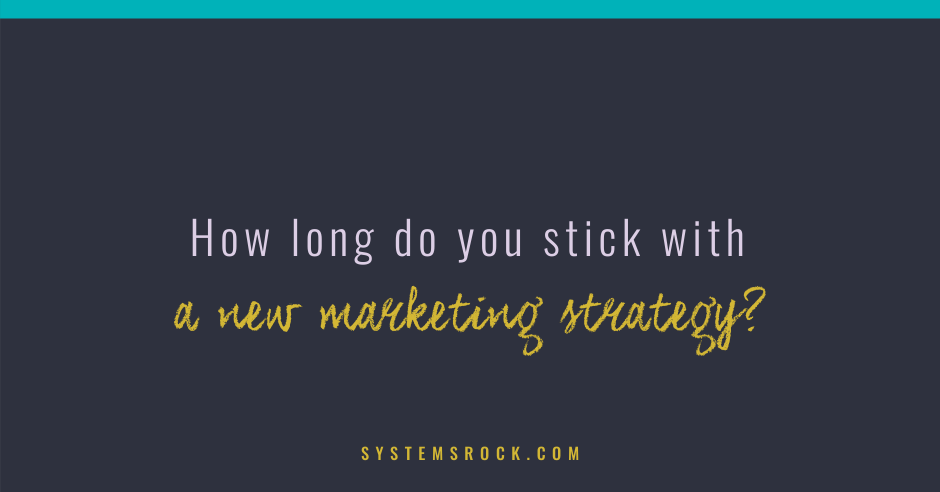Last week I did a virtual presentation for my friend’s mastermind group. One of the questions I received made me realize how drastically my approach to making business decisions has changed over the years.
The question was seemingly simple.
How long do you stick with a new marketing strategy before deciding whether to continue doing it or not?
This question brought back flashes of memories. I vividly remember that in the early years of running my business I’d decide to try a new marketing strategy just because someone said it worked for them. I’d plan it out and start implementing the strategy. But it wouldn’t take long before I’d stop doing it, because it didn’t feel it was going anywhere, or I’d get bored executing it, or I’d hear about something new and more exciting…
I say it without judgment towards my younger self or anyone else using this approach now. It’s a part of growing up as a business owner.
However, it was interesting hearing myself answer that question now. I didn’t realize how much my approach has evolved until I shared it with the ladies.
So, here are my 3-part process on deciding whether to stick with a marketing strategy.
Part 1: Make a Hypothesis
Turn “Let’s see if it works” into a statement of what you want to see happen as a result. You’ve got to define what “works” means to you.
Say, you want to try Instagram. What would you want to see more of if you started doing Instagram–more clients, more email list subscribers, more listeners of your podcast?
Then, take it one step further and define “more.” Your number should be ambitious yet rooted in reality.
Attach a rough timeline to your trial run as well. Again, it will depend on what outcome you are testing for, e.g., getting new podcast listeners as a result of starting to use Instagram will most likely take less time than getting new 1:1 clients.
And remember, it’s just a hypothesis. You are a scientist testing a theory. If it doesn’t work out, it doesn’t mean anything about your self-worth or capabilities. All it means is that something went wrong with the system.
Part 2: Define Your Strategy
Here’s where you get to map out the system.
Indeed, if you want to see if Instagram is “good for your business,” you’ll need to start posting beautiful images and share Insta stories. However, simply starting to post on Instagram to see what happens will mostly result in wasted time and money.
Before you even touch Instagram, you should map out how you expect your Instagram content will get you those new customers, email subscribers, or podcast listeners.
Which means you’ll need to ask yourself questions like:
- What type of content and messages would help me to attract the right audience?
- What call to action could I use for that?
- What other content would my new followers need to consume to be ready to jump on a call with me or even just giving their email address to me?
- What podcast episode do I want them to listen to first to get them hooked?
You’ve got to take a few minutes to expand your hypothesis to map out the entire pathway including intermediary stops on the way.
Meaning, when someone sees your Instagram post, how do you expect or want them to behave? Mapping out the steps of their journey will help you see how you will accomplish the result.
Bonus points if you can measure how each one of those individual steps will perform.
Having transparency into how individual steps of your marketing campaign work is what will ultimately help you to determine whether the entire marketing strategy is worth sticking to or not.
Part 3: Test Your Strategy & Evaluate Results
So, now you have a hypothesis of the expected results of your marketing strategy and preliminary timeline. You also have an idea for how your test marketing campaign will work in theory. It’s time to put it to the test!
Start posting on Instagram and watch how well your predictions work. And don’t forget to measure how each one of those individual steps perform.
Granted, not everything can be measured. Measure as much as you can. After all, you are not after exact numbers. All you need is to be able to see trends and patterns.
And, not just the starting and ending numbers, but the numbers for intermediary steps as well.
If all you look at are the starting and ending numbers you are still very much in the dark when making a decision about whether to stick with your campaign or not.
If the campaign worked exceptionally well, you should probably stick with it. But what if you saw only average results? Does it mean that you should reinvest into something entirely new or is it worth trying to fix the problem with one of the steps?
Most likely, fixing the problem will be less expensive than starting the process all over again. But you won’t know what to fix unless you have visibility into how each one of the individual steps of your campaign performs.
So, how long do you stick with a new marketing strategy before deciding whether to continue doing it or not? For as long as improving the performance of the steps of your existing campaign is less expensive than investing in something new.
Your numbers don’t decide everything. But it’s important to have them so they can guide your decisions.


